Correction of malocclusion in children
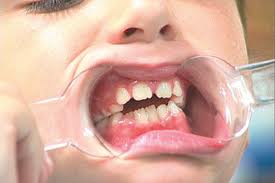
Incorrect occlusion in children is one of the main problems for both children and their parents.
First of all, this is the aesthetic problem of the child, because the presence of such a tooth defect spoils the beauty of the child’s smile.
In addition to the aesthetic problem, with an incorrect bite, children can develop gum and tooth diseases: pain in the jaw area, clicks during a conversation or eating, the risk of tooth decay increases and, as a result, tooth loss.
The correct bite is the correct ratio of the upper and lower rows of teeth with closed jaws. An ideal bite is very rare.
Of the detected malocclusion in children, approximately a third of such cases need correction. In such cases, the correction of occlusion in children is carried out by orthodontists.
At the first signs of a malocclusion in a child, it is necessary to consult a pediatrician orthodontist in a dental clinic, since any deviations are most easily treated at an early stage of their manifestation.
How does the bite develop?
There are several stages of bite development:
- The period of the newborn. There is not a single tooth in this period.
- Formed temporary bite. When teething all twenty primary teeth.
- Interchangeable or mixed bite. During this period, there are milk and permanent teeth.
- The period of formation of a permanent bite, characterized by the presence in the mouth of all molars.
Causes of malocclusion
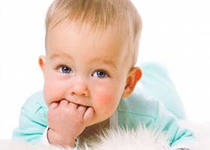
- Hereditary predisposition.
- Premature extraction of deciduous teeth.
- The presence of bad habits in a child: sucking fingers, toys.
- Prolonged use of a pacifier or dummy.
- Defects in the dentition.
- Teething delay.
- Inflammatory diseases of the gums and oral cavity.
- Eating soft or liquid foods.
- Frequent colds of the nose and throat, as a result of which the child constantly breathes through the mouth, as a result of which the formation of bones of the facial part of the skull is disturbed.
Symptoms of malocclusion in children
Improper bite in children is usually manifested by the following symptoms:
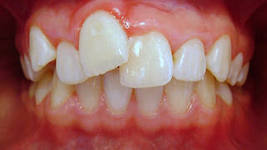
- The teeth are slightly extended forward or backward.
- When teeth are closed, an incorrect setting of the jaw is noted.
- The teeth are rotated around its own axis.
- The presence of interdental spaces.
- Rows of teeth are uneven.
The diagnosis is based on an examination of the oral cavity of the child.
In some cases, a radiological examination of the jaws of the child is carried out, as well as the production of a dental impression to determine the type of malocclusion.
Ways to correct a bite
There are five main ways to correct dentoalveolar anomalies:
- Myotherapy is a set of exercises.It is effective during a temporary bite. The exercises are aimed at restoring the normal tone of the chewing, facial and facial muscles of the bottom of the oral cavity, which has a beneficial effect on the growth and development of the jaws, and subsequently leads to the correct eruption of permanent teeth.
- The use of orthodontic appliances. Correction of malocclusion in children they are used with the help of special devices that facilitate the forced movement of teeth until they are in the correct position. If the child is no more than six years old, then plates, mouth guards or trainers are used to correct the bite. If the child is more than twelve years old, then such methods of correcting the occlusion in children will not suit them. Devices used to correct a bite can be removable and non-removable.
- Comprehensive bite correction. Complex treatment combines the hardware method with surgical procedures. It is used at the age of 6 - 12 years, as the main one, in cases when abnormalities of the dentition are pronounced and are associated with violations of teething or their size.
- Surgical intervention.
- Orthopedic bite correction.
Types of structures for correcting malocclusion in children
Plates
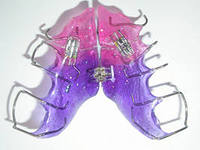
To removable structures that cause correction of the occlusion in children include plates. They can be removed, for example, during meals.
The doctor orthodontist can correct the position of the plate in the mouth with the help of special springs, loops, wire arcs.
Using the plates, you can expand the jaw, displace the teeth, prevent crowding and rid the child of bad habits.
Orthodontic Trainers
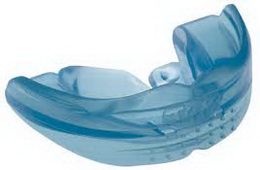
The difference between trainers and braces is that they can be used in children from an early age.
The effect of treatment with the help of trainers is faster, as the treatment itself is more comfortable for the child.
Trainers are made of silicone, they should not be worn for long: about one hour - during the day, and at night - during sleep.
Mouthguards
With their help, you can easily and quickly fix the wrong bite. The advantage of these devices is that they can be removed if necessary, the absence of a sense of discomfort and high aesthetics (they are almost invisible on the teeth).
Braces
Fixed structures are installed for the entire period of correction of the bite. Non-removable devices include bracket - systems. They consist of a wire arc, which is fixed in special locks. Locks stick to the surface of the tooth. Each lock is responsible for the position of a particular tooth.
Due to the tension of the arc, the dentition is leveled. Braces are the most preferred device for resolving all types of malocclusion.
Types of braces:
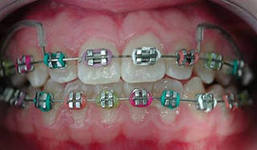
- Metal braces are the cheapest and less aesthetic. This design is made of several parts, which are made in the form of various figures. For others, metal braces will be more noticeable than other types of braces.
- Braces made of plastic. Such bracket systems are the most popular among children.
- Sapphire braces. They are made from artificial sapphire crystals. The advantage of such designs is that they are almost invisible to others. They get used to them very quickly and are easy to care for. But sapphire braces have flaws. For example, the fragility of the structure. Therefore, you will have to abandon the use of certain foods. This type of braces is sensitive to excessive loads. Nevertheless, sapphire braces are very popular.
- Lingual braces - a design mounted on the inside of the teeth. These are completely invisible devices. The use of a lingual system allows you to hide from others the fact of their use.The disadvantages of these braces are an expensive pleasure, therefore, not everyone can afford it. After installing the system, the child will get used to it for a long time. The design is inconvenient during meals, hygienic brushing of teeth and even during a conversation. When using lingual braces, it is necessary to observe some nutrition rules: do not use gummy candies and chewing gums, you can not drink a lot of fruit and sweet drinks.
Treatment and care
- At the beginning of treatment, the child experiences discomfort: pain, irritation, rubbing his cheeks and tongue. After a few weeks, the symptoms disappear, there remains only psychological discomfort, which eventually passes. During treatment, the main thing is compliance with the doctor’s recommendations.
- After installing any device that corrects the wrong bite, it is necessary to carefully care for the oral cavity. To do this, use a special toothbrush with paste and dental floss.
- Removable devices must also be thoroughly cleaned and rinsed.
- A regular visit to the orthodontist is required to monitor and correct the structure used to correct malocclusion in children.
Correction of a malocclusion with the help of braces lasts, usually, one and a half to two years or more.
Video: Braces
Prevention of malocclusion
With the onset of teething of permanent teeth in a child, it is necessary to visit an orthodontist. At this age, preventive measures are possible to prevent violations of the development of the jaws and teeth of the child.
Prevention measures:
- The use of myotherapy.
- Prevention of the development of jaw alignment at an early age by grinding the cutting edges and tubercles.
- Massage the lips to increase their elasticity, massage the frenum of the tongue and alveolar processes of some teeth.
Questions and answers
Young parents care about the future condition of their child’s teeth.
They are interested in such questions: At what age do you need to visit an orthodontist for the first time? Maybe it's better to wait for the change of milk teeth to permanent, and only then go to the orthodontist?
Orthodontic specialists answer these and other questions: for the first time, an examination by an orthodontist specialist is necessary when the baby is 3-4 years old. During this period, the doctor will be able to assess the state of the future bite.
Question: Is it possible to correct a bite without using braces?
Answer: You can use a trainer instead of braces. It works well on teeth and is able to eliminate various defects in the dentition.
Question: Is it possible correction bite in children for free (is it possible, and where)?
Answer: Correcting malocclusion is a cosmetic defect. Correction of the bite is not in the list of compulsory medical insurance, therefore it is paid. Only free children with disabilities can record for free.
Question: How much does it cost to correct a bite?
Answer: To determine the cost of the service, it is necessary to examine the entire dentition. The cost ranges from 8,000 to 100,000 rubles, depending on the methodology, material and clinic.
Bite correction in children: device prices
| Type of construction | Price in rubles |
| Mouthguards | From 150,000 |
| Plates | From 8000 |
| Trainers | From 10000 |
| Braces | From 15000 |
Before and after photos
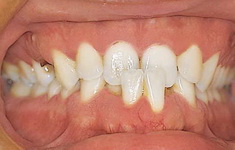 |
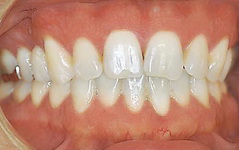 |
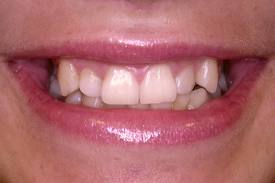 |
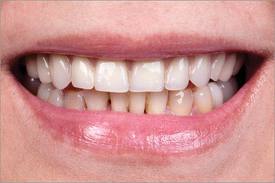 |
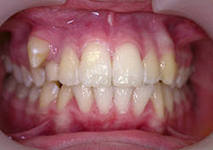 |
 |